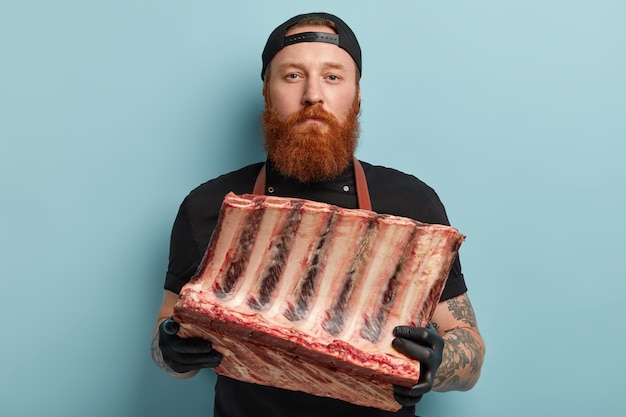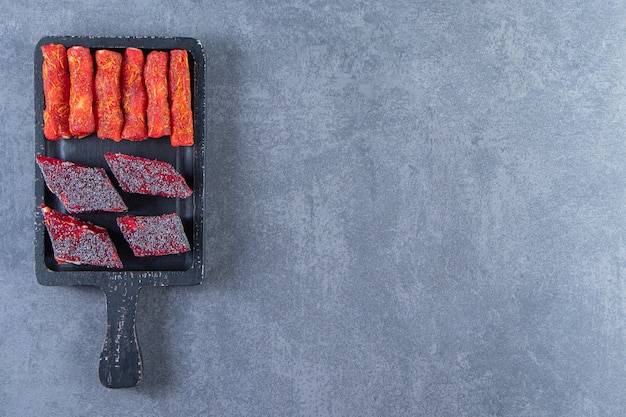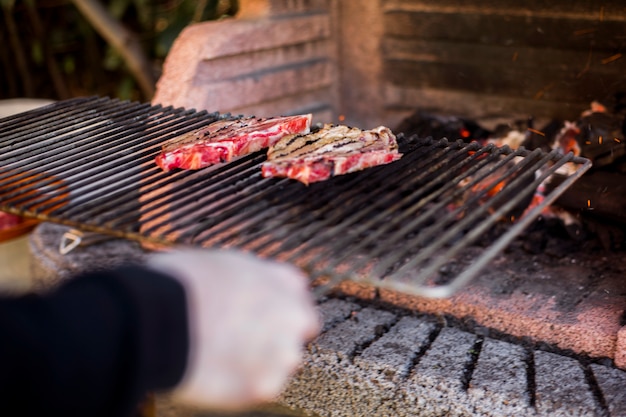Let's face it, there's something truly magical about ribs. That melt-in-your-mouth tenderness, the smoky aroma that fills the air, the way they just seem to disappear from the platter - it's pure culinary bliss. But getting those ribs just right is a bit of an art, isn't it? And while the traditional methods certainly have their charm, I've found that pellet smokers have become my secret weapon for consistently amazing results.
Now, I'm not saying you need to be a seasoned barbecue expert to conquer the art of smoking ribs with a pellet smoker. In fact, I'm convinced anyone can create delicious, fall-off-the-bone ribs with the right guidance. That's what this guide is all about - breaking down the process, sharing my tips, and answering those burning questions you might have. By the end, you'll be a confident rib-smoking master, ready to wow your family and friends with your barbecue skills.
(Part 1) Setting the Stage: Understanding the Basics

Choosing the Right Cast: Baby Backs vs. spare ribs
Before we even think about smoke and fire, let's talk about the star of the show - the ribs themselves. You've got two main contenders: baby back ribs and spare ribs.
- baby back ribs: Think of these as the "glamour shots" of the rib world. They're smaller, more tender, and have a higher meat-to-bone ratio. They're a bit more forgiving to cook, making them a fantastic choice for beginners. The flavour is fantastic - rich, succulent, and packed with that unmistakable rib-joint goodness.
- Spare Ribs: These are the larger, more substantial ribs, known for their higher fat content. They offer a bolder, more intense flavour, and when cooked right, can be a real showstopper. But be warned, they require a bit more attention and experience to get that perfect texture and prevent dryness.
Personally, I always start with baby back ribs - they're my go-to for those special occasions. But don't shy away from spare ribs if you're feeling adventurous. Once you've mastered the basics, those bad boys will become a regular fixture on your barbecue menu.
The Secret Sauce: The Importance of a Good rib rub
Okay, so you've got your ribs. Now, let's talk about the foundation of flavor - the rib rub. This magical blend of spices and seasonings is what transforms your plain old ribs into a symphony of flavour. It's not just about adding a bit of spice, it's about building layers of complexity and creating a beautiful, crusty bark that adds a whole new dimension to each bite.
You can certainly buy pre-made rubs, but I find that the magic truly lies in crafting your own. It's a simple process and so much fun to experiment with different combinations. A basic rib rub will usually include salt, pepper, paprika, garlic powder, onion powder, and a touch of brown sugar. But that's just the starting point. Think about adding herbs like thyme and rosemary, or a hint of cayenne pepper if you like things a little spicy. It's your flavour masterpiece, so go wild!
The Powerhouse: Understanding Your Pellet Smoker
Now, let's talk about your trusty pellet smoker - the heart and soul of this whole operation. This is where the magic happens, where the smoke infuses your ribs with that irresistible flavour. The first thing you need to decide is what kind of wood pellets you want to use. I always opt for hardwood pellets like hickory, pecan, or mesquite, which create that classic smoky flavour we all crave. But don't be afraid to experiment with other varieties - apple, cherry, or even oak can add a unique twist.
Once you've chosen your pellets, set your smoker to the desired temperature. For ribs, you'll typically want to aim for around 225°F (110°C). Make sure to preheat your smoker and give it a good clean before you start.
(Part 2) The Smoking Symphony: Crafting the perfect ribs

Alright, your ribs are prepped, your rub is ready, and your smoker is roaring. Now, it's time to embark on the journey of smoking your ribs to perfection. Remember, patience is key here. The beauty of slow, low-and-slow smoking is that it allows the smoke to penetrate the meat deeply, creating that tender, succulent, and flavour-packed masterpiece.
The 3-2-1 Method: A Classic Approach
The 3-2-1 method is a time-honoured technique for smoking ribs. It's a simple, reliable approach that consistently delivers amazing results. Here's the breakdown:
- 3 Hours: Start by smoking the ribs uncovered for 3 hours. This is the initial stage where the smoke does its magic, imbuing the meat with that distinct smoky flavour.
- 2 Hours: After 3 hours, wrap the ribs in foil, creating a steamy environment. Add a bit of liquid like apple juice or broth to help keep things moist. This is where the meat becomes incredibly tender.
- 1 Hour: Remove the foil and smoke the ribs uncovered for another hour. This final stage is all about achieving that glorious, crispy bark.
The Conductor: Temperature Monitoring is Key
Think of your pellet smoker like an orchestra, and temperature is the conductor. You want to maintain a steady tempo, keeping the temperature around 225°F (110°C) for optimal results. Use a good meat thermometer to check the internal temperature of the ribs - you're aiming for an internal temperature of 190°F (88°C) for perfectly cooked ribs.
The Power of Patience: Slow and Steady Wins the Race
Let's be honest, smoking ribs is not a quick process. It takes time, and it takes patience. Resist the urge to rush things. Trust the process and let your ribs cook slowly and evenly. The longer you smoke them, the more tender and flavorful they will become.
(Part 3) The Mysterious Stall: A Natural Pause in the Process

As you monitor the temperature of your ribs, you might notice something interesting: a "stall." This is where the internal temperature plateaus for a while, seemingly stalling in its climb to perfection. Don't panic - this is perfectly normal. It's simply the meat releasing moisture, which can slow down the cooking process.
The key here is to remain patient. Don't be tempted to crank up the heat. Just keep things slow and steady. Eventually, the ribs will break through the stall and continue cooking towards their delicious destiny.
(Part 4) The Grand Finale: Achieving the Perfect Bark
The bark - that crispy, caramelized outer layer - is the crowning glory of smoked ribs. It's the part that adds that satisfying crunch and elevates the overall experience. To get a beautiful bark, you want to aim for that slow and steady smoke, giving your ribs a little extra time towards the end of the cooking process.
One little trick I like to use is a spray bottle. During the last hour of smoking, I'll mist the ribs with a mixture of apple cider vinegar and water. This creates a steamy environment that helps to encourage the bark to develop, giving it that perfect texture.
(Part 5) Rest and Relaxation: Letting the Ribs Settle In
After all that hard work, your ribs are finally ready to be unveiled. But hold on! It's not time to dive in just yet. You need to give those ribs a little time to rest. This allows the juices to redistribute throughout the meat, making them even more tender and flavourful.
Wrap your finished ribs in foil and let them rest for at least 30 minutes. The longer you can resist those tempting smells, the better.
(Part 6) From Basic to Bold: Delicious rib rub recipes
Now, let's talk about the heart of flavour - those incredible rib rub recipes. Remember, these are just starting points, so feel free to experiment and find your own perfect combination.
Classic Rib Rub
| Ingredient | Quantity |
|---|---|
| Salt | 2 tablespoons |
| Black Pepper | 1 tablespoon |
| Paprika | 1 tablespoon |
| Garlic Powder | 1 tablespoon |
| Onion Powder | 1 tablespoon |
| Brown Sugar | 1 tablespoon |
This simple blend creates a rich, smoky flavour that will have everyone asking for seconds.
Spicy Rib Rub
| Ingredient | Quantity |
|---|---|
| Salt | 2 tablespoons |
| Black Pepper | 1 tablespoon |
| Paprika | 1 tablespoon |
| Garlic Powder | 1 tablespoon |
| Onion Powder | 1 tablespoon |
| Brown Sugar | 1 tablespoon |
| Cayenne Pepper | 1/2 teaspoon |
| Chili Powder | 1/2 teaspoon |
For those who love a bit of heat, this rub will add a kick to your ribs without overpowering the natural flavour.
Herby Rib Rub
| Ingredient | Quantity |
|---|---|
| Salt | 2 tablespoons |
| Black Pepper | 1 tablespoon |
| Paprika | 1 tablespoon |
| Garlic Powder | 1 tablespoon |
| Onion Powder | 1 tablespoon |
| Brown Sugar | 1 tablespoon |
| Dried Thyme | 1 teaspoon |
| Dried Rosemary | 1 teaspoon |
This rub adds a touch of herbaceous complexity to your ribs, creating a delightful blend of earthy and smoky notes.
(Part 7) Troubleshooting: Tackling Common Rib-Smoking Challenges
Even the most seasoned rib-smoking pros face a few hurdles from time to time. It's part of the learning process, and it's nothing to fear. Here are a few common problems and how to troubleshoot them:
Dry Ribs: Keeping Things Moist
Ribs are naturally lean, so keeping them moist is essential for achieving that succulent texture. If your ribs are turning out dry, here are a few things to check:
- High Smoke Temperature: If the temperature in your smoker is too high, it can cause the ribs to dry out. Double-check your smoker's settings and make sure to maintain that steady 225°F (110°C).
- Not Enough Liquid: During the foil wrap stage, adding a bit of liquid like apple juice or broth can help to steam the ribs and keep them moist. Don't be shy with the liquid!
- Overcooking: Just like any other meat, overcooked ribs can become dry. Keep a close eye on the internal temperature and remove them from the smoker once they reach 190°F (88°C).
Ribs Falling Apart: Finding the Sweet Spot
Ribs that fall apart too easily can be a bit of a bummer, especially when you're trying to serve them beautifully. This can happen when they're overcooked.
- Too High Temperature: Again, temperature is key. If the temperature is too high, it can cause the meat to break down too quickly.
- Not Enough Fat: Ribs with less fat content tend to be more prone to falling apart. Spare ribs, with their higher fat content, can handle a bit more heat.
- Over-Wrapping: Leaving ribs in foil for too long can make them excessively tender. Follow the 3-2-1 method and only wrap them during the second stage.
Uneven Cooking: Ensuring Consistency
If you're finding that some parts of your ribs are cooked more than others, it could be due to uneven heat distribution in your smoker.
- Check Your Smoker: Ensure your smoker is set up properly and that the heat is distributing evenly.
- Rotate the Ribs: Periodically rotate the ribs during the smoking process to ensure even cooking.
(Part 8) FAQs: Solving Your Rib-Smoking Mysteries
Here are a few frequently asked questions that might be swirling in your mind:
Q: What kind of wood pellets should I use?
A: Hardwood pellets like hickory, pecan, or mesquite are best for smoking ribs. They provide a rich, smoky flavour that complements the meat well.
Q: How long should I smoke ribs?
A: The cooking time for ribs can vary depending on the size and cut. Using the 3-2-1 method, you can expect to smoke ribs for around 6 hours.
Q: How do I know when ribs are done?
A: Ribs are done when the internal temperature reaches 190°F (88°C). You can use a meat thermometer to check the temperature. The ribs should also be tender and easily pull apart with a fork.
Q: Can I smoke ribs in a gas grill?
A: You can technically smoke ribs in a gas grill, but it won't be as authentic as using a pellet smoker. Gas grills don't provide the same consistent smoke flavour.
Q: What's the best way to serve ribs?
A: There's no wrong way to serve ribs, but I like to serve them with classic barbecue sides like coleslaw, baked beans, and potato salad.
And there you have it, folks, your comprehensive guide to smoking ribs with a pellet smoker. Now, get out there and show those ribs who's boss! Remember, practice makes perfect, and don't be afraid to experiment and find your own unique style. Happy smoking!
Everyone is watching

Corn on the Cob: The Ultimate Guide to Perfectly Cooked Ears
Healthy MealsAh, corn on the cob. Just the name evokes images of sunny days, barbecues, and that sweet, juicy flavour that ...

Perfect Pork Roast Oven Cooking Time: A Guide to Delicious Results
Healthy MealsThere's something truly satisfying about a perfectly roasted pork. The aroma alone is enough to make your mout...

Scallops: The Ultimate Guide to Perfect Cooking
Healthy MealsAh, scallops. Those delicate, sweet, and utterly delicious morsels of the sea. They hold a special place in my...

Ham Cooking Time: How Long to Bake, Smoke, or Boil a Delicious Ham
Healthy MealsAh, ham. It's a classic, isn't it? A real crowd-pleaser, especially around holidays. And when done right, it'...

Spaghetti Squash: The Ultimate Guide to Cooking and Serving
Healthy MealsRemember that time you saw spaghetti squash at the supermarket, looking all bumpy and strange, and thought, "W...
